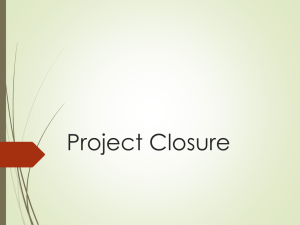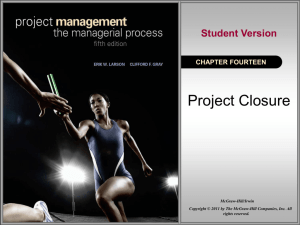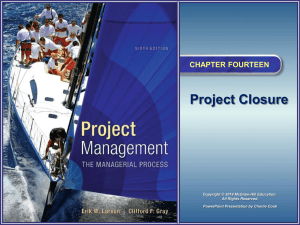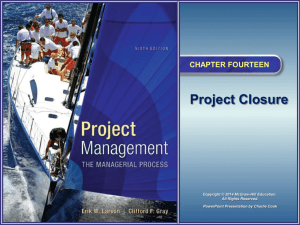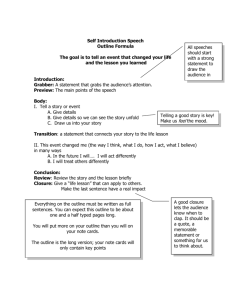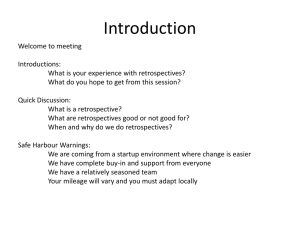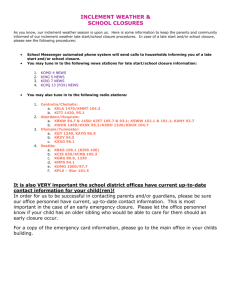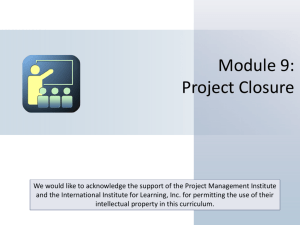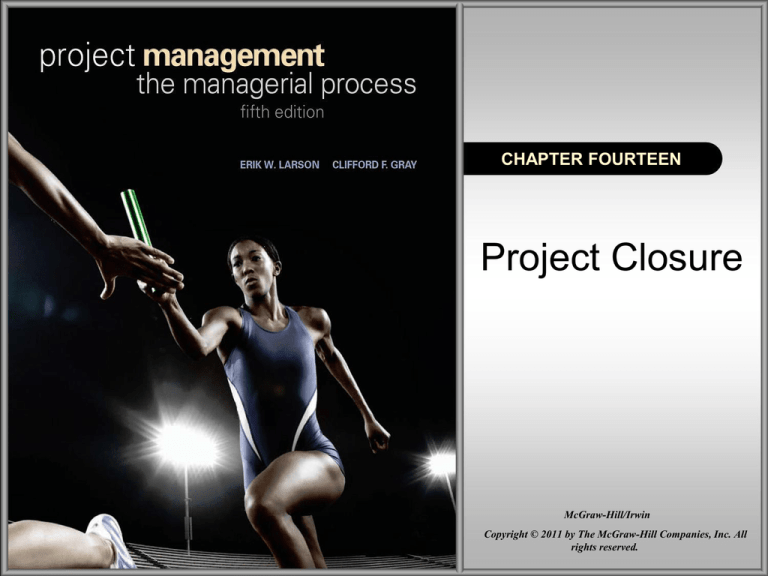
CHAPTER FOURTEEN
Project Closure
McGraw-Hill/Irwin
Copyright © 2011 by The McGraw-Hill Companies, Inc. All
rights reserved.
Where We Are Now
14–2
Major Tasks of Project Closure
1. Evaluate if the project delivered the
expected benefits to all stakeholders.
• Was the project managed well?
• Was the customer satisfied?
2. Assess what was done wrong and
what contributed to successes.
3. Identify changes to improve
the delivery of future projects.
14–3
Project Monitoring Activities
• A review of why the project was selected.
• A reassessment of the project’s role
in the organization’s priorities.
• A check on the organizational culture to ensure it
facilitates the type of project being implemented.
• An assessment of how well the project team is
functioning well and if its is appropriately staffed.
• A check on external factors that might change
where the project is heading or its importance.
• A review of all factors relevant to the project
and to managing future projects.
14–4
Project Closure and Review Deliverables
FIGURE 14.1
14–5
Project Closure
• Types of Project Closure
– Normal
– Premature
– Perpetual
– Failed Project
– Changed Priority
• Close-out Plan:
Questions to be Asked
– What tasks are required
to close the project?
– Who will be responsible
for these tasks?
– When will closure begin
and end?
– How will the project be
delivered?
14–6
Wrap-up Closure Checklist
TABLE 14.1
14–7
Implementing Closedown
1. Getting delivery acceptance
from the customer.
2. Shutting down resources
and releasing to new uses.
3. Reassigning project team members.
4. Closing accounts and paying all bills.
5. Evaluating the project team, project team
members, and the project manager.
14–8
Creating the Final Report
• Executive Summary
– Project goals met/unmet
– Stakeholder satisfaction
with project
– User reactions to quality
of deliverables
• Analysis
– Project mission and
objective
– Procedures and
systems used
– Organization resources
used
• Recommendations
– Technical improvements
– Corrective actions
• Lessons Learned
– Reminders
– Retrospectives
• Appendix
– Backup data
– Critical information
14–9
Project Performance Evaluations
• Reasons for Poor-Quality Project
Performance Evaluations:
–Evaluations of individuals are left to
supervisors of the team member’s
home department.
–Typically measure team performance only
on time, cost, and specifications.
14–10
Pre-Implementation Conditions: Team
• Are standards and goals for measuring performance clear,
challenging, and attainable? Lead to positive consequences?
• Are responsibilities and performance standards known
by all team members?
• Are team rewards adequate? Management believes teams
are important?
• Is there a career path for successful project managers
• Does the team have discretionary authority to manage
short-term difficulties?
• Is there a high level of trust within the organization culture?
• Are there criteria beyond time, cost, and specifications?
14–11
Sample Team Evaluation and Feedback Survey
TABLE 14.2
14–12
Project Performance Evaluation: Individual
• Performance Assessment Responsibilities:
–Functional organization or functional matrix: the
individual’s area manager.
• The area manager may solicit the project manager’s opinion
of the individual’s performance on a specific project.
–Balanced matrix: the project manager and the area
manager jointly evaluate an individual’s performance.
–Project matrix and project organizations: the project
manager is responsible for appraising individual
performance.
14–13
Conducting Performance Reviews
• Begin by asking the individual to evaluate his or
her own performance.
• Avoid drawing comparisons with other team members;
rather, assess the individual in terms of established
standards and expectations.
• Focus criticism on specific behaviors rather than
on the individual personally.
• Be consistent and fair in treatment of all team members.
• Treat the review as one point in an ongoing process.
14–14
Individual Performance Assessment
• Multirater appraisal (“360-degree feedback)
–Involves soliciting feedback concerning team
members’ performance from all of the people
that their work affects.
• Project managers, area managers, peers,
subordinates, and customers.
14–15
Retrospectives
• Lessons Learned
–An analysis carried out during and shortly after the
project life cycle to capture positive and negative
project learning—“what worked and what didn’t?”
• Goals of Retrospectives
–To reuse learned solutions
–To stop repetitive mistakes
14–16
Retrospectives (cont’d)
• Barriers to Organizational Learning
–Lack of post-project time for developing lessons
–No post-project direction or support for teams
–Lessons become blame sessions
–Lessons are not applied in other locations
–Organizational culture does not recognize
value of learning
14–17
The Value of Retrospective Analyses
• Making Retrospectives Effective:
–Use an independent facilitator to guide the project
team through the analysis project activities.
–Include a minimum of three in-process learning gates
during the life project cycle.
–Designate a team member as owner for each point in
the retrospective.
–Develop an easy-to-use learning repository to ensure
future utilization of retrospective lessons.
–Mandate use of retrospectives as part of the normal
process for all projects.
14–18
Characteristics of a Facilitator
1. No direct involvement or direct interest in the project.
2. Perceived as impartial and fair
3. Respect of senior management and other project
stakeholders.
4. Willingness to listen.
5. Independence and authority to report results without
fear of recriminations from special interests.
6. Perceived as having the best interests of the
organization in making decisions.
7. Broad-based experience in the organization or
industry.
14–19
Initiating the Retrospective Review
• Have automatic times or points when reviews will
take place. Avoid surprises.
• Conduct reviews carefully and with sensitivity
• Review staff must independent from the project.
• Review reports need to be used and accessible.
• Reviews support organizational culture
• Project closures should be planned and orderly.
• Certain “core conditions” must be in place to support
team and individual evaluation.
• Conduct individual and team evaluations separate
from pay or merit reviews.
14–20
The Retrospectives Process
FIGURE 14.2
14–21
Conducting a Retrospective Analysis
• Initiation and Staffing
• Data Collection and Analysis
• Reporting
14–22
Project Process Review Questionnaire
1. Were the project objectives and strategic
intent of the project clearly and explicitly
communicated?
10. Were communication methods
appropriate and adequate among all
stakeholders? Explain.
2. Were the objectives and strategy in
alignment?
11. Is the customer satisfied with the
project product?
3. Were the stakeholders identified and
included in the planning?
12. Are the customers using the project
deliverables as intended? Are they
satisfied?
4.
5.
Were project resources adequate for this
project?
Were people with the right skill sets
assigned to this project?
6. Were time estimates reasonable and
achievable?
7. Were the risks for the project
appropriately identified and assessed
before the project started?
8. Were the processes and practices
appropriate for this type of project?
Should projects of similar size and type
use these systems? Why/why not?
9. Did outside contractors perform as
expected? Explain.
13. Were the project objectives met?
14. Are the stakeholders satisfied their
strategic intents have been met?
15. Has the customer or sponsor accepted
a formal statement that the terms of the
project charter and scope have been
met?
16. Were schedule, budget, and scope
standards met?
17. Is there any one important area that
needs to be reviewed and improved
upon? Can you identify the cause?
TABLE 14.3
14–23
Organizational Culture Review Questionnaire
1.
Was the organizational culture supportive for this type of project?
2.
Was senior management support adequate?
3.
Were people with the right skills assigned to this project?
4.
Did the project office help or hinder management of the project?
Explain.
5.
Did the team have access to organizational resources (people,
funds, equipment)?
6.
Was training for this project adequate? Explain.
7.
Were lessons learned from earlier projects useful? Why? Where?
8.
Did the project have a clear link to organizational objectives?
Explain.
9.
Was project staff properly reassigned?
10. Was the Human Resources Office helpful in finding new
assignments? Comment.
TABLE 14.4
14–24
Archiving Retrospectives
• Classifying of Projects:
– Project type
– Size
– Staffing
– Technology level
– Strategic or support
– Issues and problems
– Project mission and objectives
– Procedures and systems used
– Organization resources used
14–25
Key Terms
Lessons learned
Organization evaluation
Performance review
Project closure
Project evaluation
Project facilitator
Retrospective
Team evaluation
360-degree review
14–26
Appendix 14.1
Project Closeout
Checklist
Project Closeout
Checklist
14–28
Appendix 14.2
Euro Conversion—
Project Closure
Checklist
Euro Conversion—
Project Closure
Checklist
14–30

